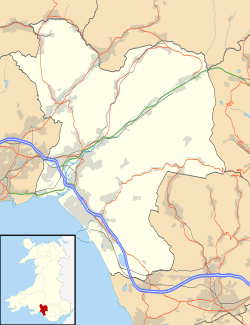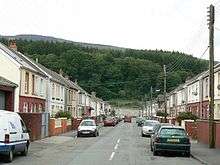Glynneath
Glynneath (Welsh: Glyn-nedd), also spelt Glyn Neath, is a small town, community and electoral ward lying on the River Neath in the county borough of Neath Port Talbot, Wales. It was formerly in the historic county of Glamorgan. Glynneath ward covers only part of the community, with some 840 electors included in the neighbouring ward of Blaengwrach.
Glynneath
| |
|---|---|
 Glynneath Town Hall | |
 Glynneath Location within Neath Port Talbot | |
| Population | 4,278 (2001)[1] |
| OS grid reference | SN8706 |
| Community |
|
| Principal area | |
| Ceremonial county | |
| Country | Wales |
| Sovereign state | United Kingdom |
| Post town | NEATH |
| Postcode district | SA11 |
| Dialling code | 01639 |
| Police | South Wales |
| Fire | Mid and West Wales |
| Ambulance | Welsh |
| UK Parliament | |
| Senedd Cymru – Welsh Parliament |
|
Industrialisation reached Glynneath when coal mining started in 1793, and rapidly expanded when the Neath Canal came to the village in 1775. Many features of the old canal still survive to the present time.[2]
There are waterfalls to the north east at Pontneddfechan near the Brecon Beacons and large parts of the rural area are heavily forested.
Notable buildings


Glynneath is home to the ruins of Aberpergwm House. Once owned by Rhys ap Siancyn, Aberpergwm House became the home of the Williams family, Welsh gentry with a strong tradition of using the Welsh language over English. Their descendants include the last of the Welsh household bards Dafydd Nicolas and folksong collector Maria Jane Williams. The Williams' family motto y ddioddefws y orfu (He who suffers, triumphs) was adopted by Glamorgan County Council. The mansion itself was remodelled in 1876 but is now derelict and little of note remains of the building.
St. Cadoc's Church, in the grounds of Aberpergwm House, was built as a chapel in the 17th century, rebuilt in 1808-1809 for the Aberpergwm Williams family and extended in 1836-41. It is a Grade II* listed building.[3]
Rheola House, a Regency house designed c.1812 by the eminent architect John Nash, is also Grade II* listed.[4]
Sports and leisure
Glynneath used to host one of motor sport's most important challenges, the British round of the World Rally Championship (formerly known as the Lombard RAC rally or Rally GB). Some of the biggest names in motor sport have taken part and have failed to complete the British round.
Glynneath also has an association with downhill mountain biking with the Welsh National Championships being held at Rheola.
Glynneath is home to Glynneath RFC, a rugby union club founded in 1889.
Notable residents
- The Anchoress, musician, was born in the town.
- Max Boyce, comedian and singer, closely linked to Welsh rugby culture.
- Julie Gardner, television producer, responsible for the successful relaunch of Doctor Who.
- Leslie Hardman, British Army chaplain and rabbi, who was among the liberators of Bergen-Belsen concentration camp, was born in the town.
- Ruth Madoc, actress, best known for her role as Gladys Pugh in the television sitcom Hi-De-Hi!
- Siwan Morris, actress, who has appeared in the television series Belonging, Caerdydd, and Skins.
- January Rees, Wales women's rugby union player, comedian[5][6]
- Emlyn Walters, Bradford Northern and Wales rugby league footballer.
Twin Town
Glynneath is twinned with:

The town twinning supports football matches between the two towns, and a visit by Glynneath Male Voice Choir.
References
- "Community population 2011". Retrieved 12 April 2015.
- The Welsh Academy Encyclopaedia of Wales John Davies, Nigel Jenkins, Menna Baines and Peredur Lynch (2008) pp322 ISBN 978-0-7083-1953-6
- "Church of Saint Cadoc, Glynneath". British Listed Buildings. Retrieved 16 January 2014.
- "Rheola House, Glynneath". British Listed Buildings. Retrieved 16 January 2014.
- Porter, Nicola (2 January 2002). "Interview - January Rees: I scare men & they love it; Funnygirl January Rees tells why she quit rugby to make it as a rude stand-up". Daily Mirror. London. Retrieved 23 July 2018.
- Haines, Chris (25 December 2008). "January Rees comes to Rhondda". Wales Online. Retrieved 23 July 2018.
